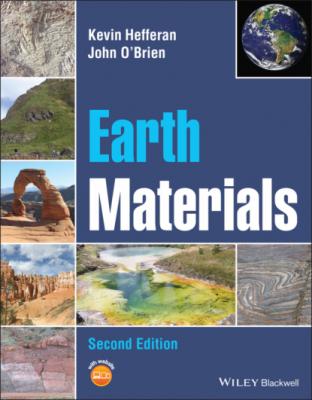Earth Materials. John O'Brien
Читать онлайн.| Название | Earth Materials |
|---|---|
| Автор произведения | John O'Brien |
| Жанр | География |
| Серия | |
| Издательство | География |
| Год выпуска | 0 |
| isbn | 9781119512219 |
Library of Congress Cataloging‐in‐Publication Data applied for
Paperback ISBN: 9781119512172
Cover Design: Wiley
Cover Images: © Kevin Hefferan, Earth image © NASA
Preface
Earth Materials encompass the minerals, rocks, soil, and water that constitute our planet and the physical, chemical, and biological processes that produce them. Since the expansion of computer technology in the last two decades of the twentieth century, many universities have compressed or eliminated individual course offerings such as mineralogy, optical mineralogy, igneous petrology, sedimentology, and metamorphic petrology and replaced them with Earth materials courses. Earth materials courses have become an essential curricular component in the fields of geology, geoscience, Earth science, engineering geology, environmental geology, and many related areas of study. This textbook is designed to address the needs of a one or two semester Earth materials course. It can also serve as a text for those individuals who want or need an expanded background in minerals, rocks, soils, and water resources.
The chapters featured in this textbook illuminate key topics in Earth materials including their:
1 Properties, origin, and classification
2 Associations and relationships in the context of Earth’s major tectonic, petrologic, hydrologic, and biogeochemical systems
3 Uses as resources and their fundamental role in our lives and the global economy
4 Relation to natural and human induced hazards
5 Impact on health and the environment.
This textbook provides:
1 Comprehensive descriptive analysis of Earth materials
2 Color graphics and insightful texthe in a logical integrated format
3 Field examples and regional relationships with graphics that illustrate concepts discussed
4 Examples of how concepts discussed can be used to address real world issues
5 Contemporary references from current scientific journals related to developments in Earth materials research
6 Summative discussions of how Earth materials are interrelated with other science and nonscience fields of study.
Chapter 1 contains an introduction to Earth materials and an overview that includes a discussion of Earth’s interior and plate tectonics. This introductory chapter provides a global framework for following chapters. Chapters 2–6 constitute the minerals portion of the textbook. Chapter 2 addresses mineral chemistry, bonding mechanisms, and classification. Chapter 3 explores fundamentals of crystal chemistry, including ionic substitution, phase diagrams, and isotope geochemistry. Chapter 4 highlights the principles of crystallography including symmetry operations, crystal lattices, and crystal systems. Chapter 5 examines mineral formation, macroscopic mineral properties, and the major groups of rock‐forming minerals. Chapter 6 focuses on the microscopic optical properties of minerals and petrographic microscopic techniques.
Chapters 7–10 encompass the igneous portion of the textbook. Chapter 7 discusses the composition, textures, and classification of igneous rocks. Chapter 8 describes the origin and evolution of magmas and plutonic structures. Chapter 9 vividly presents volcanic processes and landforms in all their wonder. Chapter 10 explores igneous rock associations and their relations to plate tectonics.
Chapters 11–15 focus on sedimentary rocks and processes. Chapter 11 addresses weathering, sediment production, and soils. Chapter 12 discusses the sedimentary cycle, the agents, and processes by which sediments are eroded, transported, and deposited and how they imprint sediments deposited in different environments. Chapters 13 and 14 examine the composition, textures, classification, and origin of detrital sedimentary rocks and biochemical sedimentary rocks that include carbonates, evaporites, siliceous rocks, iron formations, phosphates, and carbon‐rich sedimentary materials that include coal, petroleum, and natural gas.
Chapters 15–18 address metamorphic rocks and processes. Chapter 15 introduces metamorphic agents, processes, protoliths, and types of metamorphism. Chapter 16 discusses metamorphic structures, stresses, and deformation processes. Chapter 17 investigates metamorphic rock textures and classification. Chapter 18 concentrates on metamorphic zones, facies, facies series, and metamorphic trajectories in relationship to plate tectonics.
